Hostile Planet Filmmakers Interview - Part 1
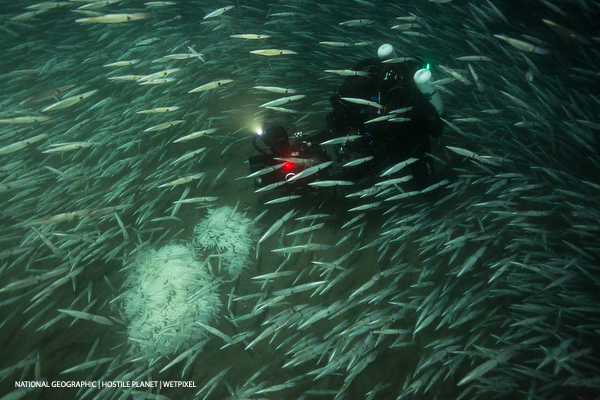
National Geographic’s series Hostile Planet aims to show the struggle for life in the natural world. The production company, Plimsoll Productions describes the series:
“Earth may be the only place we know that’s teeming with diverse life, but that doesn’t make it a benign planet. Against all the odds, species have found ways to survive in the world’s most inhospitable landscapes – from a scorched desert to the frozen tundra. Every day is a struggle to survive, but animals continue to surprise us by adapting to the toughest challenges. Set against the backdrop of a more violent and volatile climate, the epic battles for survival take on a new urgency as animals face intensified wildfires, blizzards, droughts and downpours. To some, the unique challenges are too much, but others, it presents new opportunities. HOSTILE PLANET is an epic drama told in an intimate manner with new camera technology allowing a close-up vantage point as the animals navigate through their changing landscapes.”
Hostile Planet is currently airing internationally on National Geographic Channel. Please also check out and follow @natgeochannel on Instagram.
National Geographic’s Planet or Plastic? The initiative is a global, collaborative commitment to significantly reduce the amount of single-use plastic that reaches the ocean by raising awareness, elevating science and education, advancing innovation and inspiring action.
Learn more about the Planet or Plastic? Initiative and take the pledge at natgeo.com.
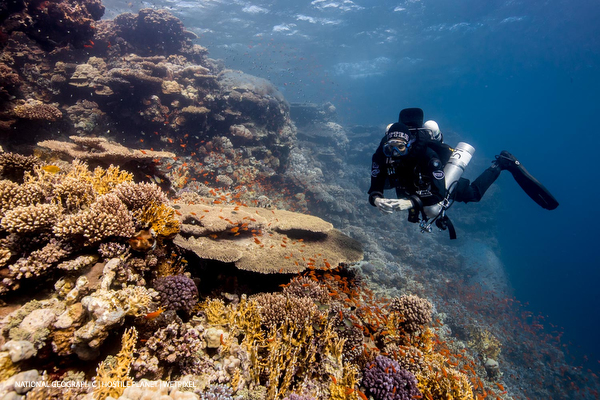
The “Oceans” episode focuses on incredible stories about marine creatures. Wetpixel reached out to the Director of the episode, Sophie Morgan (@sophiedives), and camera operators Dan Beecham (@danbeecham) and Roger Munns (@roger.munns) to find out more about the production. As an aside, you should follow these guys on Instagram!
Wetpixel: The premise of the show is to look at the harshness of nature. How did you storyboard this? Did you select the events and write the story around it or vice versa?
Sophie: The Ocean show feels quite different to the rest of the series in that, rather than one distinct habitat, everything from crushing depths, through endless watery deserts to turbulent coasts is covered in one film. It felt important to select stories that reflected a journey through a range of habitats and the variety of challenges marine animals face, so we chose the ‘journey’ first and selected the stories that worked. There were also beats I knew I wanted to hit in terms of human-induced issues these animals face, with regard to things like climate change and overfishing, so from the start we worked hard to integrate them into the episode without losing a sense of beauty or drama.
Wetpixel: The amazing events featured must have taken some researching. How did you-you choose which ones to film?
Sophie: I think as a wildlife filmmaker you never stop looking for stories, so I had ideas and more important contacts to bring to the table to find new behaviors. Camera crew, scientists and fishermen, were all vital in providing intel that developed our portfolio of potential stories. However, the brief was to break away from the classic landmark mold and make something more dynamic, so that shaped the sequences we ran with. Part of this was leading with stories from a character POV, so we were careful to select charismatic animals like turtles and penguins that we could engage with and also get close to in order to keep with the immersive feel of the series. These are very popular animals for filmmakers, so we worked extra hard to find the new angle – we were thrilled for example to find an original take on great white shark predation. With the whole ocean to choose from it was key to make sure that every story felt fresh, engaging and progressed the storyline, so really deserved its place.
Wetpixel: Were there any significant mishaps? Did the animals behave as expected?
Dan: When filming a significant marine event like the Herring Run in Norway, you have to expect the unexpected. Of course, you make a plan, and you hope that you’ll get to stick to it, but you have to be prepared for nature to rewrite the rulebook. This is what happened when we went out to try and shoot this behavior for the series. This event doesn’t happen in the same place every year - it moves, but the season when we went out to film it, it had jumped a significant distance up the coast. Our first day on the water we saw absolutely nothing - just empty ocean. We initially thought maybe we were early and everything would start arriving soon, but then we found out the event was happening much further north than we’d anticipated. Without hesitation, we made the call to move up the coast so we could be on the action. The new location was a much deeper Fjord than where I had previously worked on this event, and as such the orca was only getting the herring to the surface very late in the day - the working days are already very short in Norway at this time of year, and available light levels very low. The dramatic topography of this Fjord and the effect this had on the behavior made it very tough to get onto the action in the tiny working windows when the herring are at the surface, and there is still light to film. Fortunately, we were working with a very experienced skipper and guide who were able to find the action for us and get us in the water.
Roger: Turtles mate all year round at Sipadan but there are peaks and troughs in the activity. For the type of event we wanted to film, with multiple males, we were more likely to have success in the peak mating season. Unfortunately, that coincides with some of the worst surface conditions and visibility of the year. Our plan was to go slightly earlier when conditions were better but take the risk that activity might be reduced. It paid off with some beautiful visibility, and we were fortunate to get in on a really dramatic mating event.
Wetpixel: Given the “tough” image of the program, were the filming conditions very challenging and/or arduous?
Sophie: Filming an underwater event in hurricane season was always going to be risky, but during the mullet run shoot we encountered one of the worst years yet for hurricanes and tropical storms in Florida and the working conditions were incredibly difficult – as well as not delivering great images, being amongst baitfish and sharks in zero visibility is not an ideal scenario.
Barrie Britton’s long lens topside images of fish toppling through waves and into the mouths of predators were really dramatic, but Didier Noirot had to go out twice the year afterward to get any underwater shots. He also got hit by a toxic red tide at one point, which prevented him from getting in for at least a week. The penguins crew also encountered the worst storm to hit the Falklands in 30 years – great for the action of rockhoppers being battered by waves, but they had to film the whole thing huddled behind a cliff for protection!
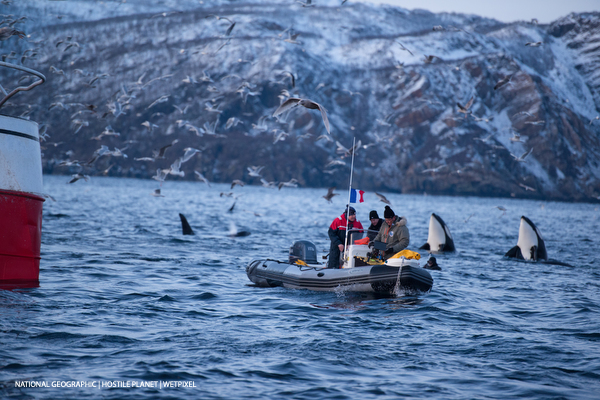
Dan: Filming the orca in Norway was a tough gig. The water temperature is somewhere in the 2-5 degrees Celsius range, depending on the time of year and the area. We use thick open-cell wetsuits for this kind of work - drysuits are too bulky and cumbersome, and generally, you’re not in the water for too long. But when you get out the wind can be howling - you need to be careful not to let your core temperature drop, so you’re ready in case the action kicks off again. We got onto a couple of good situations, which saw us being in the water to close to an hour. When it got to the stage where I couldn’t feel my fingers to focus the camera anymore, that was good indicator that it was time to get out! The other tough thing is just the lack of light and how short the days are. Generally on an ‘open ocean’ type shoot you’ll have around a month on location - when you consider that the days are so short in Norway at the time of year when this is all happening, its almost like your potentially productive time on location has been halved - so you have to get really lucky to get good stuff when there’s still light. Working around active fishing boats was also challenging. We played things very safe for this work - the safety diver that was with me was wearing a full-face mask with communications gear to the surface, so we always knew what the fishing boat was doing - if they were going to move, or if anything was changing with the nets. Doing things any other way, or without the cooperation of the crew on the fishing boat (which we always had) is too dangerous, and not worth the risk. The final thing is being in the water next to such big animals. When you’re right alongside an Orca, you realize just how big they are. We had one situation where we were in the water after the sun had dipped below the horizon, on a big bait-ball, with around a dozen orca around us. We ended up getting out as it was too dark to shoot and even to see them coming. It was one of those situations where you have moments where you think to yourself “what the hell am I doing here? Is this really a good idea?” When dissecting the event, later on, we compared being in the water with them to running alongside a pride of lions on the hunt - which may sound a bit dramatic, we know that ultimately they aren’t interested in us as prey, but these are wild and potentially dangerous animals.
Roger: I was filming in the tropics. The water temperature was around 28ºC, and the surface conditions were pretty much glassy and hot. So it wasn’t the toughest shoot I’ve ever been on in that respect! Certainly a lot easier than working in the freezing, dark waters of Norway! However spotting mating turtles is extremely difficult, even in ideal conditions. We had a large area to scour, and we spent 12hrs a day driving around looking for the proverbial needle in a haystack. In tropical heat with very little breeze it becomes very hard to stay mentally alert. Especially when there has been nothing to see for hours or days on end. That mental element was extremely challenging. When we did spot a mating pair, we had to move very quickly. A snorkeler would head over straight away to get eyes on before the turtles dove. He would then track them, and I would then gear up and head over. Female turtles move extremely quickly when mating and the event can last up to 6hrs + so following them underwater is really like running a marathon. Often I’d be finning as fast as I could simply to keep them in view, let alone get any shots.
Wetpixel: How long did the filming take?
Sophie: For the series, the core filming period was approximately two years, often with multiple teams out on location at the same time. Overall Hostile Planet logged approximately 1,800 hours of footage in 82 shoots over 1,300 days of filming and employed 245 crew members on location.
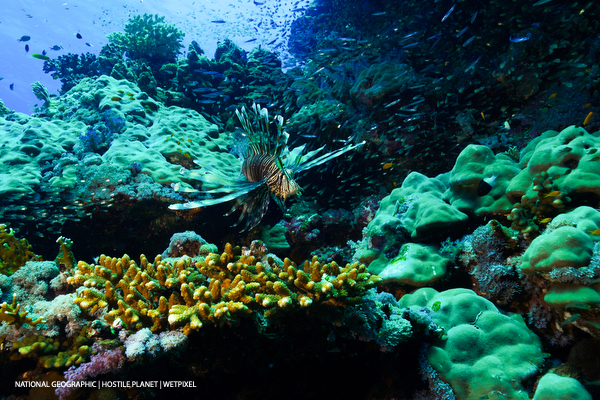
Wetpixel: Where did you film during the making of the series?
Sophie: The series filmed across all seven continents and, between the Oceans and Polar episodes, in every ocean. The Oceans team worked through a real range of underwater conditions with time spent diving in polar, temperate and tropical waters.
Wetpixel: What did you film?
Sophie: There was a whole range of ocean cast – from microscopic jellyfish polyps to the biggest animal on the planet, the mighty Blue Whale. The episode showcases real diversity and some oddball alien-esque characters but also features the heavy hitters like sharks and orca. Sometimes it is the tempestuous ocean itself that becomes the lead character – the storm/wave sequence is both breath-taking and terrifying at the same time.
Wetpixel: Were there any specific things that you saw or filmed that fascinated you? What was your favorite event during the filming?
Sophie: I get very excited by new behavior so heading out to film the mullet run and seeing the first drone shots from the great white shoot was incredibly exciting. The orca shoot also mind-blowing, unbelievably I’d never seen one before and was suddenly surrounded by more than 100! However, one of the sequences I’m most proud of is the jellyfish reproduction – the way in which the polyps multiply in the hundreds and then split into stacks of tiny jellyfish, something we captured in time-lapse, is one of the weirdest things I’ve ever filmed. They really are absolutely minuscule at that stage, and cameraman Tim Shepherd did a blinding job of making them feel like monsters.
Dan: The ways in which the orca ‘work’ a bait ball is just amazing to me. There is true coordination, understanding, and strategy between the orca in the way this works. I’m also fascinated to see the way in which the orca so delicately eat the individual Herring - they don’t eat the whole fish, rather they use their tongues to carefully ‘fillet’ them in their mouths, spitting out a delicately crafted fish skeleton - amazing!
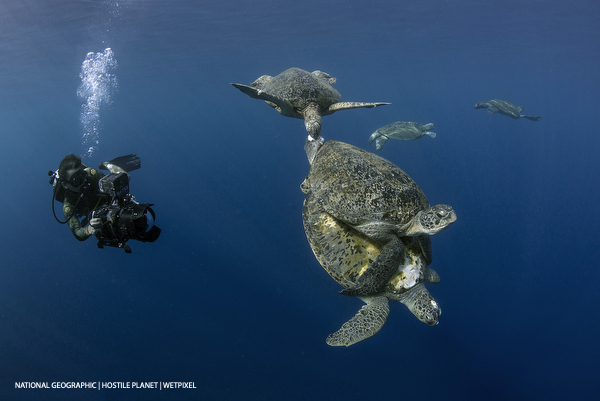
Roger: The persistence and single-mindedness of the male turtle which was mating was truly outstanding. He was having chunks of flesh torn off him by the pursuing males. He was being hit on the head and having the air knocked out of him, and he clung on grimly throughout. They were so oblivious to my presence that I could shoot the biting with a macro lens literally inches away from the flippers. That’s a real privilege. Sometimes I did just have to look over the top of the camera and take it in.
Wetpixel: What was the most important thing that you learned while making the series? What advice would you offer to aspirant filmmakers and producers?
Sophie: Surround yourself with a good team. We had quite a few difficult shoots on the series, and it was a testament to the camera ops, production staff, divers, boat crew and scientists supporting us that we succeeded in gaining the needed footage. Sometimes you have to band together to not give up – I had a very cold, ill birthday on an arctic shoot that was not going to plan, but my teammates put a tealight in my porridge and made me smile the whole of the 7-hour drive to the next location.
As a reminder, Hostile Planet is currently airing internationally on National Geographic Channel. Check out natgeo.com for more info or to watch and please follow @natgeochannel on Instagram.
Part two of this interview series is here.